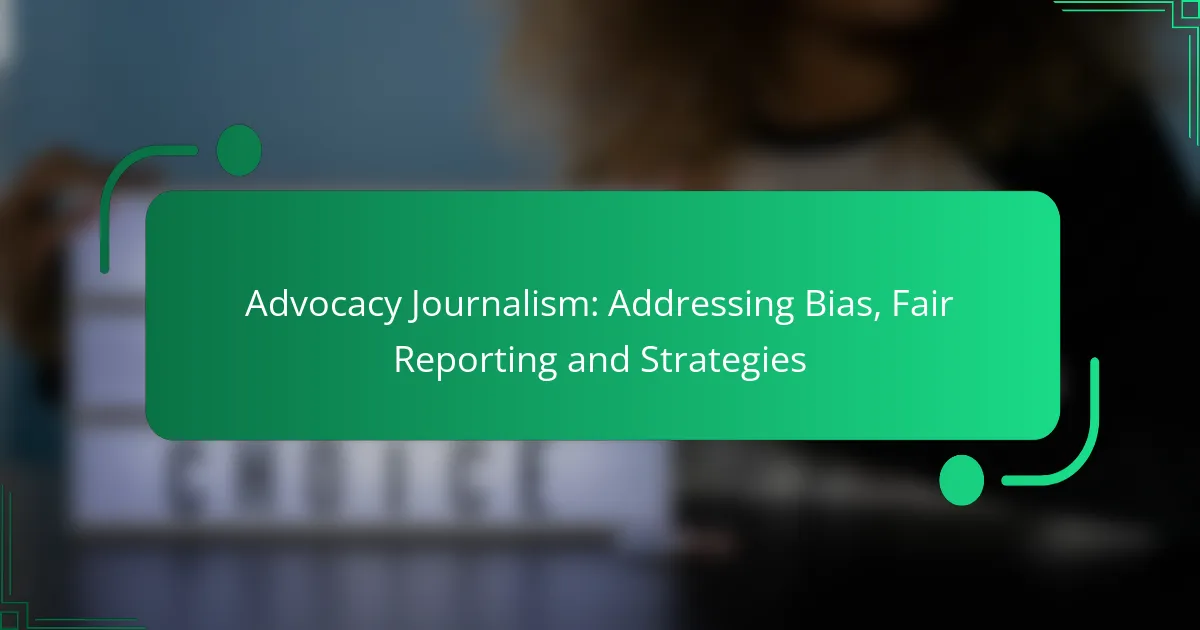Advocacy journalism plays a vital role in combating bias and ensuring fair reporting by prioritizing accuracy and diverse perspectives. By implementing structured approaches, such as transparent sourcing and community engagement, journalists can create coverage that reflects a wide range of voices and issues. This form of journalism not only amplifies marginalized narratives but also fosters accountability and informed public discourse.

How can advocacy journalism address bias in reporting?
Advocacy journalism can address bias in reporting by implementing structured approaches that prioritize accuracy and fairness. This involves establishing clear protocols, diversifying sources, and training journalists to recognize their own biases.
Implementing fact-checking protocols
Fact-checking protocols are essential for ensuring the accuracy of information presented in advocacy journalism. By establishing a systematic process for verifying claims, journalists can reduce the risk of disseminating biased or misleading information. This may include cross-referencing multiple reputable sources and using established fact-checking organizations.
For effective fact-checking, journalists should develop a checklist of criteria to evaluate sources, such as credibility, relevance, and potential conflicts of interest. Regular audits of published content can also help identify and correct any inaccuracies promptly.
Utilizing diverse sources
Diverse sourcing is crucial for minimizing bias in reporting. By incorporating perspectives from various stakeholders, journalists can present a more balanced view of the issues at hand. This includes seeking out voices from different demographics, political affiliations, and cultural backgrounds.
To ensure diversity, journalists should actively seek sources beyond their usual networks. This might involve reaching out to community organizations, experts in specific fields, or individuals with firsthand experience related to the topic being covered.
Training journalists on bias recognition
Training journalists to recognize their own biases is a vital step in promoting fair reporting. Workshops and seminars focused on bias awareness can help journalists identify their preconceptions and understand how these may influence their work. This training should also cover the impact of language and framing on audience perception.
Incorporating regular bias recognition training into professional development can foster a culture of self-reflection among journalists. Encouraging peer reviews and discussions about potential biases in reporting can further enhance awareness and accountability within news organizations.
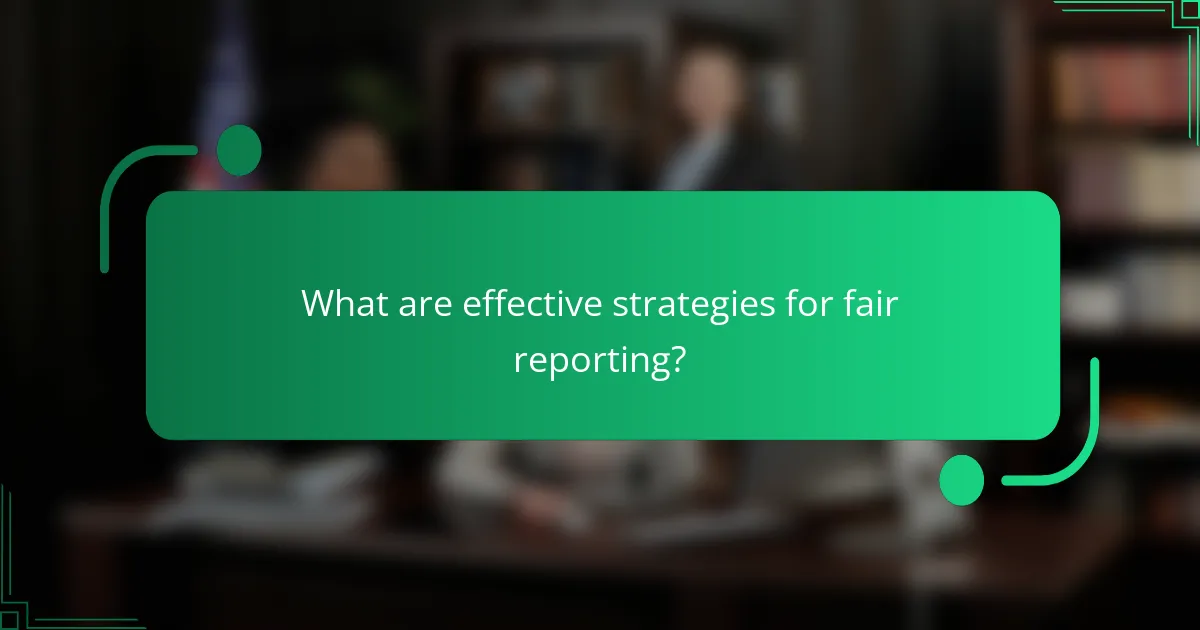
What are effective strategies for fair reporting?
Effective strategies for fair reporting include adopting transparency in sourcing, engaging with community feedback, and balancing perspectives in coverage. These approaches help ensure that journalism is accurate, equitable, and reflective of diverse viewpoints.
Adopting transparency in sourcing
Transparency in sourcing involves clearly identifying the origins of information used in reporting. Journalists should disclose their sources whenever possible, which builds trust with the audience and enhances credibility.
Consider using hyperlinks to original sources or providing context about how information was gathered. This practice not only informs readers but also allows them to verify claims independently.
Engaging with community feedback
Engaging with community feedback is crucial for understanding the perspectives and concerns of the audience. Journalists should actively seek input through surveys, social media, or public forums to gauge community sentiment on various issues.
Incorporating feedback can lead to more relevant reporting and foster a sense of ownership among community members. It’s important to respond to criticism constructively and adjust coverage as needed to reflect diverse viewpoints.
Balancing perspectives in coverage
Balancing perspectives in coverage means presenting multiple sides of a story to provide a comprehensive view. Journalists should strive to include voices from different backgrounds and experiences, especially those that are often marginalized.
When covering contentious issues, aim for a mix of expert opinions and personal narratives to enrich the narrative. This approach not only enhances fairness but also helps audiences understand the complexity of the issues at hand.
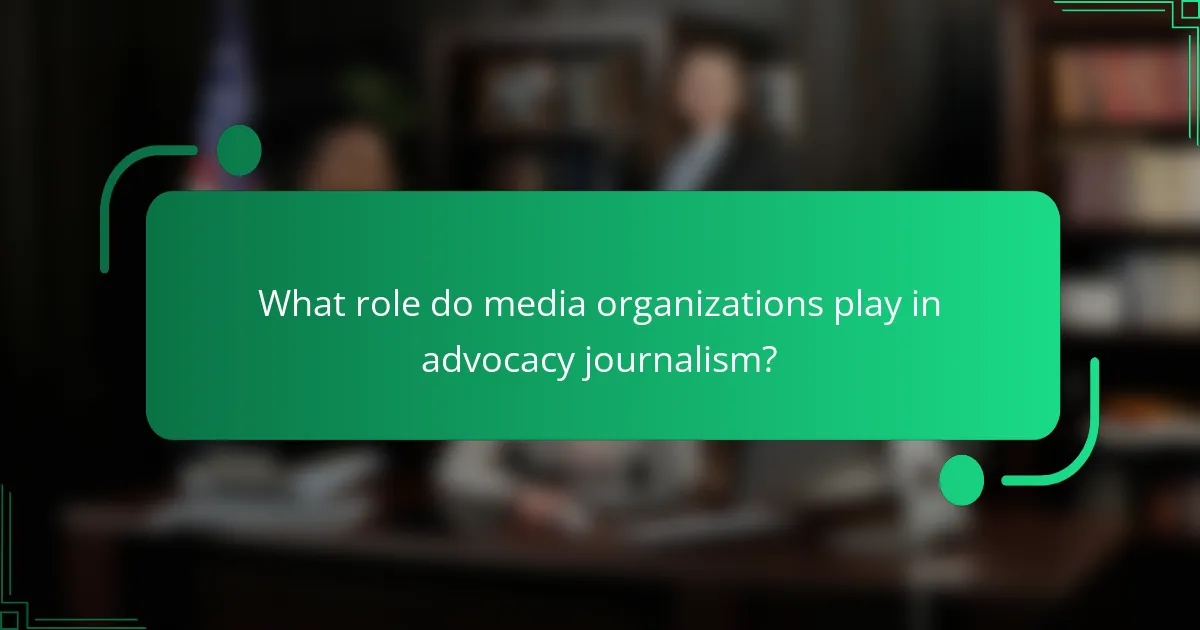
What role do media organizations play in advocacy journalism?
Media organizations serve as crucial platforms for advocacy journalism by amplifying marginalized voices and addressing social issues. They shape public discourse through reporting that highlights injustices and promotes accountability.
Establishing editorial guidelines
Establishing clear editorial guidelines is essential for media organizations engaged in advocacy journalism. These guidelines should outline the principles of fairness, accuracy, and transparency, ensuring that reporting remains credible while advocating for specific causes.
For example, organizations might implement policies that require multiple sources for controversial claims or mandate the disclosure of potential conflicts of interest. This helps maintain trust with the audience while pursuing advocacy goals.
Promoting ethical journalism standards
Promoting ethical journalism standards is vital for maintaining integrity in advocacy journalism. Media organizations should adhere to established codes of ethics, such as those from the Society of Professional Journalists, which emphasize the importance of truth, fairness, and minimizing harm.
To ensure ethical practices, organizations can conduct regular training sessions for journalists on bias recognition and fact-checking. This not only enhances the quality of reporting but also reinforces the organization’s commitment to responsible journalism.
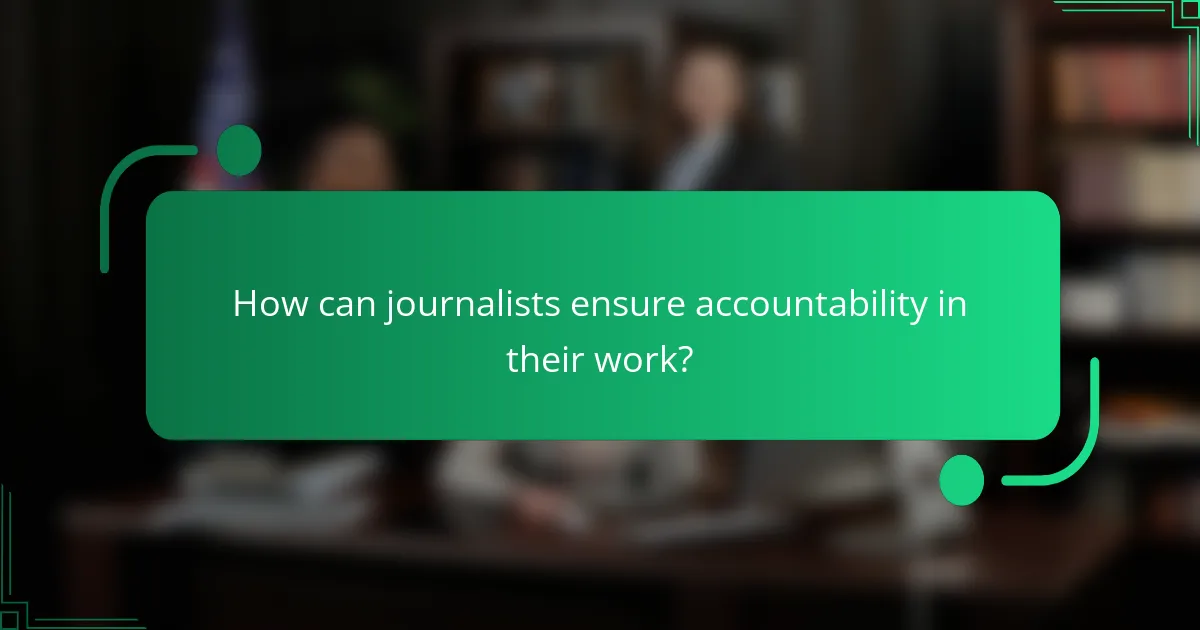
How can journalists ensure accountability in their work?
Journalists can ensure accountability by adhering to ethical standards, conducting regular reviews of their reporting practices, and fostering an environment of transparency. This commitment helps maintain credibility and trust with the audience.
Regular audits of reporting practices
Regular audits involve systematic evaluations of reporting methods and outcomes to identify biases and inaccuracies. Journalists should review their sources, fact-checking processes, and the overall fairness of their narratives.
Implementing a checklist for audits can help streamline this process. Key items might include verifying source credibility, assessing the balance of perspectives, and ensuring adherence to ethical guidelines. Conducting these audits quarterly can be effective for maintaining high standards.
Encouraging public scrutiny
Encouraging public scrutiny involves inviting feedback from the audience and stakeholders about the reporting. This can be achieved through open forums, social media engagement, and direct communication channels.
Journalists should actively seek out critiques and suggestions, as this interaction can reveal blind spots and enhance the quality of reporting. Establishing a transparent feedback mechanism, such as a dedicated email or online platform, can facilitate this process and strengthen community trust.
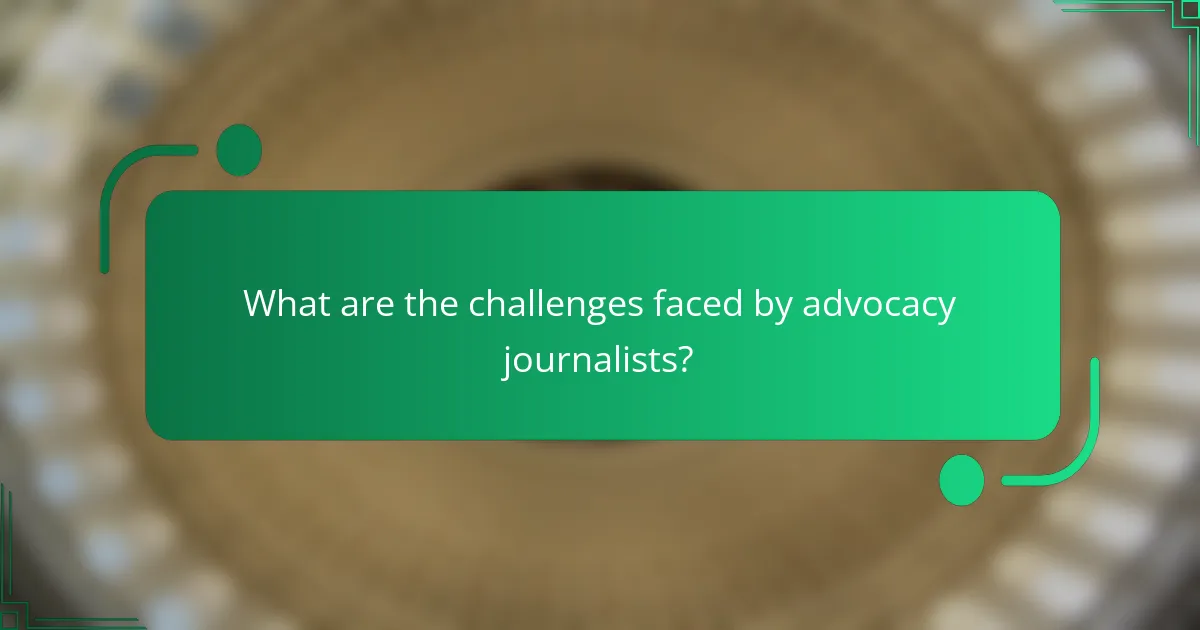
What are the challenges faced by advocacy journalists?
Advocacy journalists encounter several challenges, primarily related to maintaining credibility while promoting specific causes. These challenges include balancing objectivity with advocacy and navigating funding pressures that can influence reporting.
Balancing objectivity with advocacy
Advocacy journalists must strive to present information fairly while also championing particular issues. This requires a careful approach to ensure that their reporting does not become biased, which can alienate audiences and undermine trust.
To achieve this balance, journalists can adopt strategies such as presenting multiple viewpoints, using fact-checking to support claims, and clearly distinguishing between reporting and opinion. For example, when covering a controversial topic like climate change, including expert opinions from both sides can provide a more rounded perspective.
Navigating funding pressures
Funding sources can significantly impact the work of advocacy journalists, often leading to conflicts of interest. Many advocacy organizations rely on donations or grants, which can create pressure to align reporting with the interests of funders.
To mitigate these pressures, journalists should seek diverse funding streams and maintain transparency about their financial backers. Establishing clear editorial guidelines that prioritize independent reporting can also help maintain integrity. For instance, a journalist funded by an environmental group should disclose this relationship when reporting on related issues to uphold credibility.

How can advocacy journalism evolve in the digital age?
Advocacy journalism can evolve in the digital age by embracing new technologies and platforms that enhance engagement and transparency. By integrating innovative strategies, journalists can more effectively address bias and promote fair reporting while reaching wider audiences.
Leveraging social media for outreach
Social media platforms are essential tools for advocacy journalism, allowing journalists to share stories, engage with audiences, and mobilize support. Utilizing platforms like Twitter, Facebook, and Instagram can amplify messages and foster community discussions around critical issues.
To maximize outreach, journalists should consider creating shareable content, such as infographics or short videos, that resonate with their target audience. Regular interaction with followers through comments and live sessions can also build trust and encourage further dialogue.
Utilizing data journalism techniques
Data journalism techniques enhance advocacy journalism by providing evidence-based insights that support claims and narratives. Journalists can analyze datasets to uncover trends, highlight disparities, and present compelling stories that resonate with the public.
Incorporating visualizations, such as charts and maps, can make complex data more digestible. Journalists should ensure their data sources are credible and transparent, following best practices for data ethics to maintain integrity and trustworthiness in their reporting.

What are emerging trends in advocacy journalism?
Emerging trends in advocacy journalism include increased collaboration among news outlets and a heightened focus on local issues and grassroots movements. These trends reflect a shift towards more community-oriented reporting and a collective approach to addressing social and political challenges.
Increased collaboration between news outlets
Collaboration between news organizations is becoming more common as they seek to amplify their impact and reach. By pooling resources, journalists can cover complex issues more comprehensively and share diverse perspectives. This approach often leads to joint investigations or shared reporting on significant topics, enhancing credibility and depth.
For example, multiple outlets may work together on a single story, allowing them to combine their findings and present a more nuanced view. This trend is particularly beneficial in regions where local news resources are limited, as it helps ensure that important stories are not overlooked.
Focus on local issues and grassroots movements
Advocacy journalism is increasingly centering on local issues and grassroots movements, reflecting a growing recognition of the importance of community voices. Journalists are prioritizing stories that resonate with local audiences, often highlighting the efforts of activists and organizations working to effect change at the community level.
This focus allows for more relevant reporting that can directly influence public opinion and policy. For instance, covering local environmental initiatives or social justice campaigns can mobilize community support and foster greater engagement. Journalists should aim to connect with local activists to ensure accurate representation and amplify their messages effectively.
